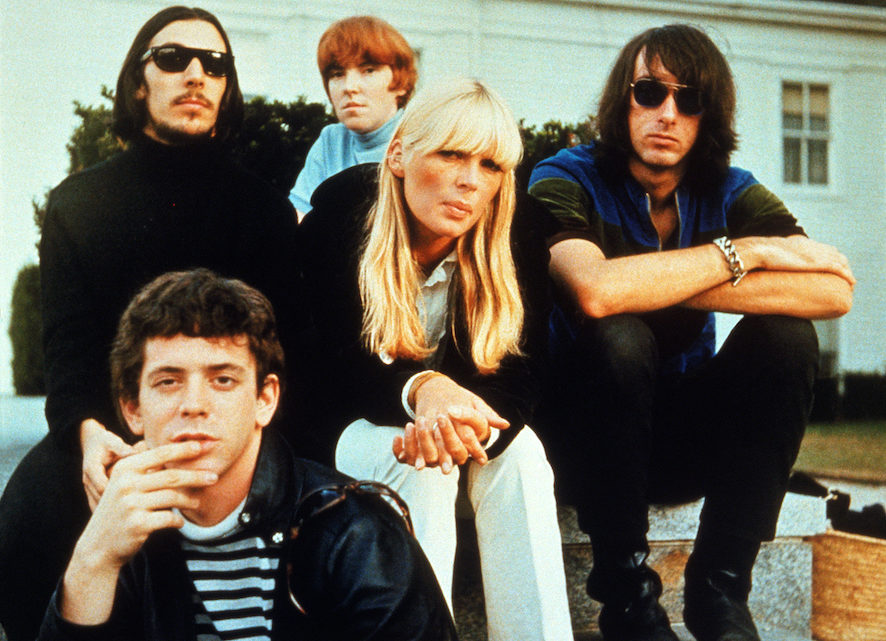Tropic Sprockets / The Velvet Underground
By Ian Brockway
In 1989, I went to the record store in Saratoga Springs, New York and became magnetized by the yellow Andy Warhol banana on a cassette titled The Velvet Underground. I put it in my Walkman and instantly jumped, full of energy. The metal hums and roars seemed like the vibrations of a machine, the sound of my wheelchair.
I turned the music up and started to paint for the first time.
The song “White Light / White Heat” about amphetamines, never fails to bring back the sensation of taking my asthma pills, Marax.
I felt some of the same tense hyperactivity when the thrumming droning chords confronted me once more in the opening of Todd Haynes’ masterful and nearly perfect documentary titled “The Velvet Underground.”
The opening which highlights a split screen photo essay of front man Lou Reed’s childhood on the left and Reed on the right filmed by Warhol in a Factory screen test is stunning, an iconic art piece by itself. Lou Reed peers glassily into the camera looking like an urban android with black curly hair, mostly bored but slightly bemused.
Reed’s sister Merrill tells us her brother was “different.” He never quite fit into the Long Island suburbs. The pale dark haired boy was attracted to unusual people, the poetry of Baudelaire and the fiction of William Burroughs and Hubert Selby Jr.
Reed’s mother approved of shock treatments for him, thinking he was gay.
Reed went to Syracuse University and met his teacher Delmore Schwartz. He started writing songs and stories, joining a group called The Primitives. Merrill Reed illustrates a dance in the documentary and it is an amusing touch. Soon after, Lou Reed meets John Cale and as they are both partygoers, the pair meets Warhol and a band, The Velvet Underground, is formed.
Andy Warhol originally wanted the group to accessorize and expand his art, projecting images onto their bodies to make a sonic silkscreen. But as the Velvet Underground grew popular at The Factory, Warhol pushed for a record contract. The added membership of Nico (the German model and actress) cemented the contract. With Nico’s deep spacey off key voice, John’s classical viola and Lou’s grinding acoustics, the band was bizarre and off-putting. Cher hated the group calling them a replacement for suicide.
Nico’s icy robotic voice was perfect for the songs “I’ll Be Your Mirror” and “Femme Fatale”. The mainstream wasn’t ready for them.
Reed and Cale were fascinated by John Cage’s work of long sustained electronic tones that encouraged a dreamy REM sleep.
Cale met the avant-garde musician La Monte who was holding a single note for several hours. The sensation sought after was something akin to meditation or hypnosis. Mark Rothko achieved this in his heavy yet ethereal abstracts and Warhol filmed multiple upon multiple hours of kissing.
The documentary flawlessly complements The Velvet Underground’s output. In split screen, director Haynes makes his own Warholian art piece by showing vivid and meaningful images alongside each musician. Each colorful square whether portrait or landscape impacts upon your eye as a visual poem. Every segment is a mosaic, illustrating the nature of sound, space and speed. The mixture of all of these elements is crucial to understanding this group’s jarring fearlessness. The band had to their credit, an eccentric female drummer, Moe Tucker.
The dare of The Velvet Underground could not be sustained. In the mid-70s, the band in black with velvet violas, dissolved. John Cale experimented and Lou Reed became a metallic cyborg poet, writing songs about street-crawlers, hustlers, and glamorous gender-fluid performers. Warhol called Lou a rat and closed The Factory door, his emotional valentine all but forgotten. Nico had a child with Alain Delon and died of a bike accident.
The final images of Reed himself who died in 2013 are haunting and impactful. In the very last one, he glares at the camera, both a Transformer and a Terminator at peace with his decibels.
This documentary is a thrill and a delight from its very opening. Haynes has made a very personal work, a visual twin to the sounds of The Velvet Underground. There is a twinge of sadness at the loss of the viola or the neon projectors that project no longer. But above all, this documentary is a vivacious and percussive joy, a call to action, to all that was once aloof, silver, discordant and black.
Write Ian at [email protected]
[livemarket market_name="KONK Life LiveMarket" limit=3 category=“” show_signup=0 show_more=0]







No Comment